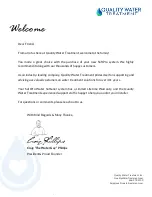
WATER SUPPLIES
15
CONDUCTIVITY -
µS/cm
TOTAL DISSOLVED SOLIDS & CONDUCTIVITY
(vitreous enamel lined water heater cylinder)
40
150
400
600
TOTAL DISSOLVED SOLIDS (TDS)
- mg/L
ANODE SELECTION
warranty applies to a vitreous enamel lined water heater cylinder if the
correct coloured anode is used for the TDS / conductivity level of water
2500
3570
no warranty
applies
to a vitreous
enamel lined
water heater
cylinder
Blue
Black
Green
60
215
570
860
0
0
Blue
ANODE INSPECTION AND REPLACEMENT
The anode installed in a vitreous enamel lined steel water heater cylinder will
slowly dissipate whilst protecting the cylinder. The life of the cylinder may be
extended by replacing the anode.
If the anode is not replaced during a five year service (refer to
“Major Five Year
Service”
on page 10) then the maximum time after installation when the anode
should be replaced for this gas water heater is 8 years.
For water supplies which are either softened, desalinated or where the water
supply may alternate between a water tank and a reticulated public supply or
another supply, it is recommended the anode be replaced within 5 years of
installation.
CAUTION
If the water supply has a TDS greater than 150 mg/L and a green anode has
not been changed to a black anode, or if the TDS is greater than 600 mg/L and
the anode has not been changed to a blue anode, there is the possibility the
anode may become overactive and hydrogen gas could accumulate in the top
of the water heater during long periods of no use. In areas where this is likely to
occur, the installer should instruct the householder on how to dissipate the gas
safely.
If, under these conditions, the water heater has not been used for two or more
weeks the following procedure should be carried out before using any electrical
appliances (automatic washing machines and dishwashers) which are
connected to the hot water supply.
The hydrogen, which is highly flammable, should be vented safely by opening a
hot tap and allowing the water to flow. There should be no smoking or naked
flame near the tap whilst it is turned on. Any hydrogen gas will be dissipated.
This is indicated by an unusual spurting of the water from the tap. Once the
water runs freely, any hydrogen in the system will have been released.
















































